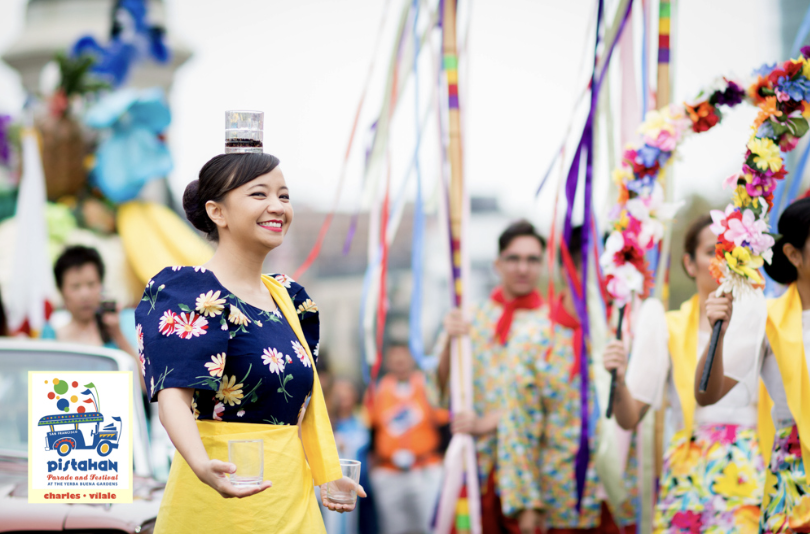
BY KYLE YOUNG
San Francisco — Among vibrant banners and bustling pavilions surrounding the center stage, hundreds of people reunited in person for the first time in two years for the Pistahan Festival at Yerba Buena Gardens.
Meaning “Having a festival” or “feasting” in Tagalog, the two-day return of Pistahan celebrates the roots of Filipino culture in San Francisco and the general Bay Area. When in person, the event continues to be the largest Filipino cultural festival on the West Coast. Although virtually during the COVID-19 pandemic, it garnered a following of almost 500,000 people globally in both 2020 and 2021.
“The last couple of years during the pandemic were really hard because we actually had to reimagine and rethink how the festival would be,” said Fatima Wright, an organizer, and attendee of the festival since the founding of Pistahan. “[But now, being back in person] the festival blows my mind because you have a whole weekend to share so much with our community [about] the beauty of being Filipino.”
The Pistahan Festival originated in 1994 in response to the displacement of San Francisco Filipinos due to the construction of the Moscone Convention Center and the Yerba Buena Gardens, and always occurs in the second week of August. On August 4th, 1977, Filipino-American (Fil-Am) residents were forcefully evicted from their accommodations in the International Hotel by fully armed riot police. This would mark the last stand of Manilatown, the Filipino cultural center in the city. The festival occurs annually after that first week to represent the rebirth of Filipino culture in San Francisco.
“To me, it’s about the celebration of our culture, of our community, our traditions. It’s about the community coming together,” said Al Perez, President of Pistahan SF. “This festival is very important for the community to have that source of rejuvenation and reconnection to re-engage with all parts of our culture.”
The festival is free for everyone to attend in order to better spread awareness and to let the city enjoy a breath of fresh air while learning about another’s culture.
The theme for the 2022 Pistahan Parade and Festival was “homecoming”; honoring roots, heritage, and community. Although the festival was attended by many Fil-Am and Filipino immigrants currently residing in the city, non-Filipinos were encouraged to actively participate to spread Pinoy pride and acceptance.
“I hope that this will evolve into amazing directions in the future, but keep its mission to broaden awareness and deepened understanding of Filipino culture and in the process sparked cultural pride,” said Perez. “I hope that [non-Filipinos] will see in a lot of ways we just like them because we care about our families. We care about our jobs or care about our culture. [But] in some ways, we’re also very unique. Our uniqueness makes us special, [rather than] weird.”
Pistahan 2022 featured eight pavilions for attendees to learn about Pinoy culture and representation within the modern world; from Tinikling dancing to how Filipinos were actively engaging in Silicon Valley.
“My parents tried to teach me about Filipino culture when I was young, but [Pistahan] is the way for me to tap into things like the arts, dance and entertainment and see how it all merges together,” says Kikani Libadia, Pistahan SF’s social media coordinator.
However, it isn’t always easy for the festival to gain attendance. Younger generations of Filipino Americans often straddle a gap between cultures, which often creates a disconnect between kids and their heritage.
“When us kids came [to the United States], our first priority was to be as American as we can. That’s just kind of protecting ourselves from harassment from being bullied,” said Perez. “The priority was to lose our accent to be as American as we can.”
Similarly, Libadia emphasized the dependency on familial-like connections in the Fil-Am community when it comes to the continuation of Filipino culture in America. Libadia believes the future of Pistahan SF is in the hands of the next generation of Fil-Am volunteers continuing the tradition.
“It’s really hard to draw young crowds to Pistahan because the majority of us initially started going because of our parents,” said Libadia. “But, when you get older, you don’t really want to go and your parents can’t always force you to.”
Even so, as a current college student and the festival’s social media coordinator, Libadia strives to connect all age gaps, from the young to the elderly.
“I think especially working with social media, one of the challenges I came across was trying to bridge that [inter]generational gap,” said Libadia. “Even so, we can appeal to everyone… Whether you’re Filipino at all, I really want people to come in and see that these are people that this is our culture and that we’re all interconnected. No matter what background you come from, there’s a lot to learn about your culture.”
By bridging traditional and contemporary, Pistahan shows people the future via the discovery of the past. Through food, dance, fashion, and technology, connecting families and building unity remain Pistahan’s main objectives.
“My favorite moment was being able to share my love for community with my children because my kids who are now teenagers volunteered at this Pistahan for the first time this year,” Wright said. “I think that was my proudest moment to date because they finally saw and understood why I do what I do for our community.”






